Zanskar, Ladakh, India - After two days when poor weather obstructed travel between Leh and Zanskar, His Holiness the Dalai Lama was able today to fly into Padum by helicopter. He was given a grand reception at the helipad by the people of Zanskar and formally welcomed by the District Commissioner, Kargil, Rakesh Kumar, the Senior Superintendent of Police, as well as three Councillors of the Ladakh Autonomous Hill Development Council. The pilot and copilot of the helicopter joined His Holiness on the ground where he thanked them for a comfortable flight and stood so they could have their photograph taken with him.
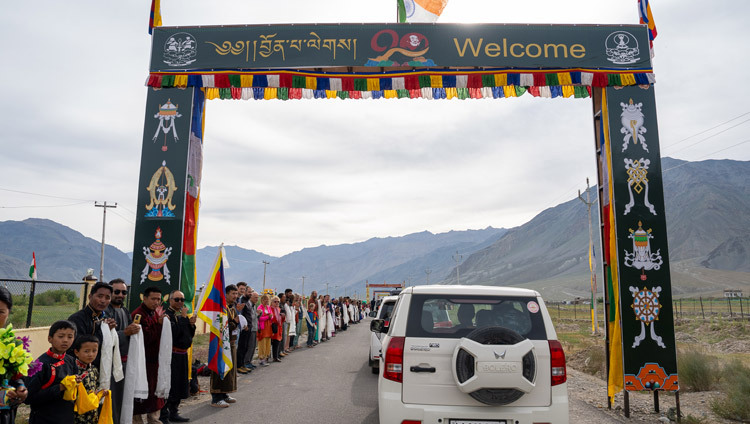
He then climbed into a car for the drive up to the new Karsha Phodrang (KarGön Palace). The road from the helipad as far as the Duzin Phodrang and then from the bridge over the Suru River and up to the new Phodrang was lined by thousands of people in their finery. Their joyful faces reflected their elation that His Holiness was among them once more and that they were able to see him as he passed. He smiled and waved in return. Yesterday, members of the public were seen weeping with disappointment that His Holiness had been unable to come. Today, they wept with joy that he had arrived.
While His Holiness was driving up to the new Phodrang, Chief Executive Councilor of the Ladakh Autonomous Hill Development Council, Tashi Gyalson, reached the temple. He paid his respects to the Tulkus before taking his own seat.
The sound of horns, drums and cymbals announced His Holiness’s arrival at the Karsha Phodrang. He was greeted at the door by the Abbot of Karsha Monastery and a representative of the Muslim community. He walked to his chair before the throne. To his right sat Thiksey Rinpoché, the Sharpa Chöjé Rinpoché and Lhagyal Tulku, while to his left sat Thamtog Rinpoché, Abbot of Namgyal Monastery.
A verse of welcome was recited:
May the sound of the great Dharma drum
Dispel the sufferings of sentient beings
May you live for an inconceivable 100 aeons
And turn the Wheel of Dharma
In the heavenly Snow Land of Tibet.
You are the source of all good and happiness,
May Tenzin Gyatso, Lord Avalokiteshvara,
Remain until the cycle of existence comes to an end.
Chair of the Organizing Committee of the Summer Mega Symposium, Geshé Losang Tsephel opened the proceedings: “With these verses of salutation to His Holiness the Dalai Lama, we pay our respects to him, expressing our gratitude to him for gracing this occasion with his presence. I also pay respects to Shartsé Chöjé Rinpoché, Thiksey Rinpoché, Namgyal Abbot Thamthog Rinpoché, the Kargil DC, Rakesh Kumar, CEC Tashi Gyalson and other dignitaries.
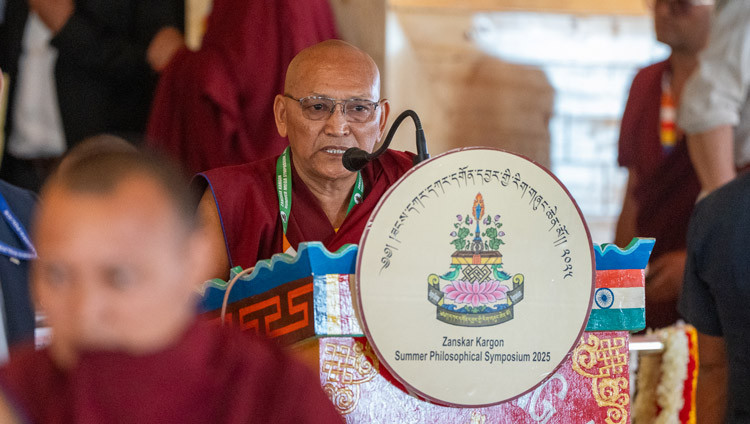
“Monasteries, nunneries and schools in Zanskar and Ladakh have taken to heart His Holiness’s advice not to leave the classic texts on the shelf unread, but to study and investigate them. This Summer Mega Symposium (Great Summer Debate) is part of that project. Focusing on this Symposium has been very beneficial for the people of Ladakh.
“His Holiness has told us that the people of the Himalayan Region have a special responsibility to keep the Buddhism of Tibet alive. Buddhist teachings have not only benefited Buddhists, but also those who simply seek happiness in this life. Their benefit extends beyond the monastic setting to include schools. Monks and nuns from Ladakh, Zanskar, Lahaul & Spiti, Kinnaur and so forth, as well as children from 27 schools are participating in this symposium at Karsha Monastery. Schoolchildren now routinely learn about ‘mind and awareness’ as well as ‘logic and reasoning’, which have become part of their mainstream curriculum.
“In short, the influence of this Summer Symposium not only affects schoolchildren positively, it creates opportunities for people of different faiths to hold discussions with one another. It is an opportunity to spread education.
“We presented our plans to His Holiness in Dharamsala. He gave us his consent and support, for which we are grateful. The Kargil DC and the CEC of the LAHDC have also been clear in their support. On behalf of the organizers, I would like to thank everyone who has given us help. I pray that His Holiness may live long and that his wishes may be fulfilled. May peace and happiness prevail throughout the world.”
The Kargil DC, Mr Rakesh Kumar, addressed the gathering. He paid respects to His Holiness and the various guests and congratulated the organizers and participants in the symposium. He sought His Holiness’s blessings for the peace and prosperity of the people of Ladakh.
Schoolchildren demonstrated how they have learned to debate. They began by reciting the verse of salutation from Nagarjuna’s ‘Root Wisdom’ and a verse of homage to His Holiness. They then recited Chapter 18 of ‘Root Wisdom’ from memory. They discussed how an altruistic attitude, the wish to help others, is the source of all happiness. They concluded with the clear assertion that an altruistic attitude can be learned about, cultivated and put into practice.
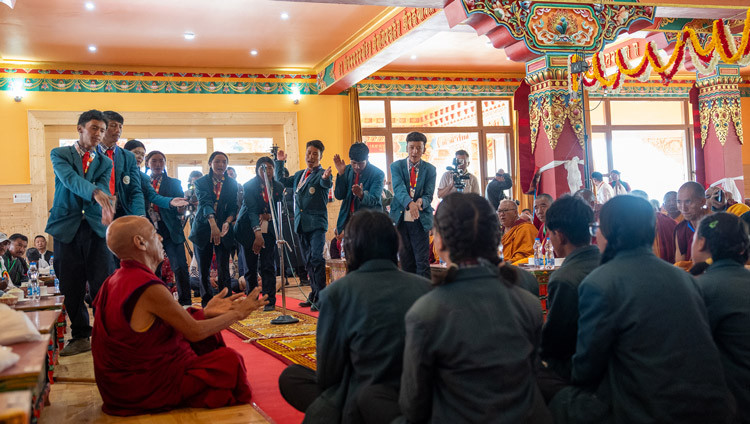
Another group discussed universals and specifics in the context of valid cognition.
Guests and organizers came forward to receive His Holiness’s blessings.
The moderator announced that the root teacher of us all, the Champion of World Peace would now be requested to address the gathering.
His Holiness began: “I left my native place in Amdo and came to Lhasa where I studied for some years. I gave public talks in Tibet and visited the great monastic seats, the centres of learning, around Lhasa.
“The Chinese Communists have taken away not only our political rights; they have also sought control of our spiritual traditions. When I was in Beijing in 1954 Mao mentioned to me that religion is poison. I believe he was sincere according to his own way of thinking, although I said nothing in return, but in my own mind I realized he was hostile to the Dharma.
“The Chinese Communist policy is that religious tradition is no more than blind faith and so deserves to be destroyed. They consider the Dharma with animosity. However, the teaching of the Buddha we uphold that combines study, reflection and meditation. The study of the great treatises in the light of logic and reason is something wonderful.
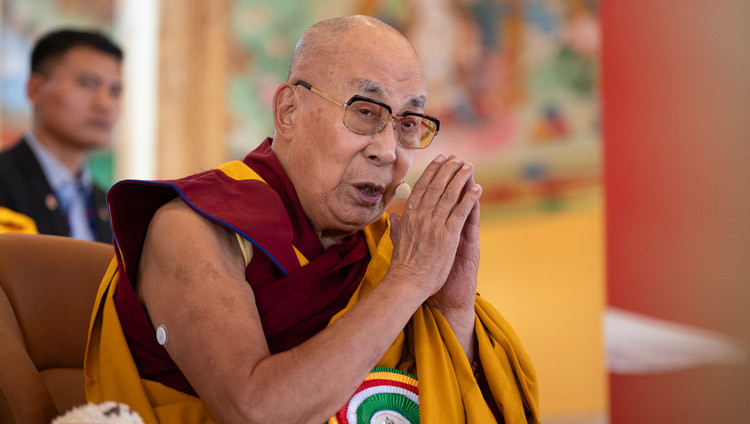
“I learned about Buddhist philosophy and logic, as well as ‘mind and awareness’, from my childhood. Being able to think about the Buddha’s teaching is invaluable. It was explained to me in terms of logic and reason. Later, I discovered that even modern scientists found our logical approach, derived as it is from the Nalanda Tradition, attractive and interesting.
“Unlike other religions that are based more on faith, in our tradition of Buddhism we place emphasis on logic and reasoning. These tools are immensely important and can help us improve our understanding of almost any topic. We don’t just take for granted what previous masters have taught.
“Because we place special emphasis on logic and reason in the way we teach and study Buddhism, Chinese Communist authorities have imposed specific restrictions on our traditions. As a result, there has been a decline and destruction of Buddhist teachings in Tibet. However, in exile we have been able to keep our traditions alive and our efforts have received substantial support from the government and people of India.
“As far as I’m concerned, I studied the classic texts and took exams for my Geshé degree. One of my most important teachers was a Mongolian master named Ngodrup Tsognyi who helped me understand the philosophy of the Middle Way. Debate with people like him enabled me to gain a good understanding of the teachings. On the basis of my own experience, I’ve learned how beneficial engaging in debate can be. It’s an approach that allows us to really use our intelligence.
“There may be times when we have to interpret what the Buddha taught. This is good. It broadens our understanding. We Tibetans in exile are a relatively small group, but because we take a logical approach, we have been able to preserve our traditions. Here in Zanskar, at this critical time, these traditions are being preserved through logic and reason—that’s all I have to say, thank you.”
Children from the Rainbow School sang the following lines and danced to the beat of a drum:
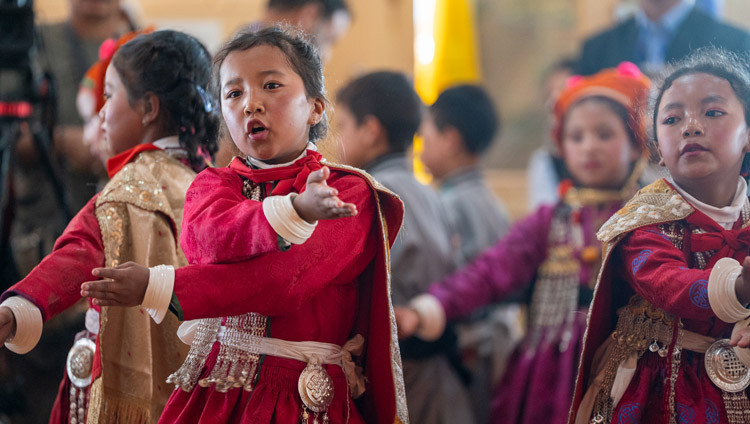
How fortunate we are to have the Wish-fulfilling Jewel here at the new Karsha Phodrang. Although you are 90 years old, you do your best. You have visited and stayed with us several times and we all have the good fortune to see you, Your Holiness. Just having the good fortune to hear Tenzin Gyatso, the Dalai Lama, our eyes fill with tears of joy. We are so fortunate to have His Holiness among us even though he is now 90 years old—thank you for coming to inaugurate this Palace.
Groups of Zanskari women in their best clothes and ornaments, some wearing tie-dyed sashes over their robes, others adorned by elaborate head-dresses decorated with turquoise and coral, performed poignant songs as they danced.
The chief organizer was called upon to deliver words of thanks. He paid homage to the Buddha who, moved by compassion dispelled wrong views. He gave an account of the costs involved in establishing the Karsha Phodrang and the funds that were raised to meet them. He thanked everyone present for coming, reserving his greatest gratitude for His Holiness, who stood up and made his way to the lift that would carry him up to his quarters at the top of the new building.












